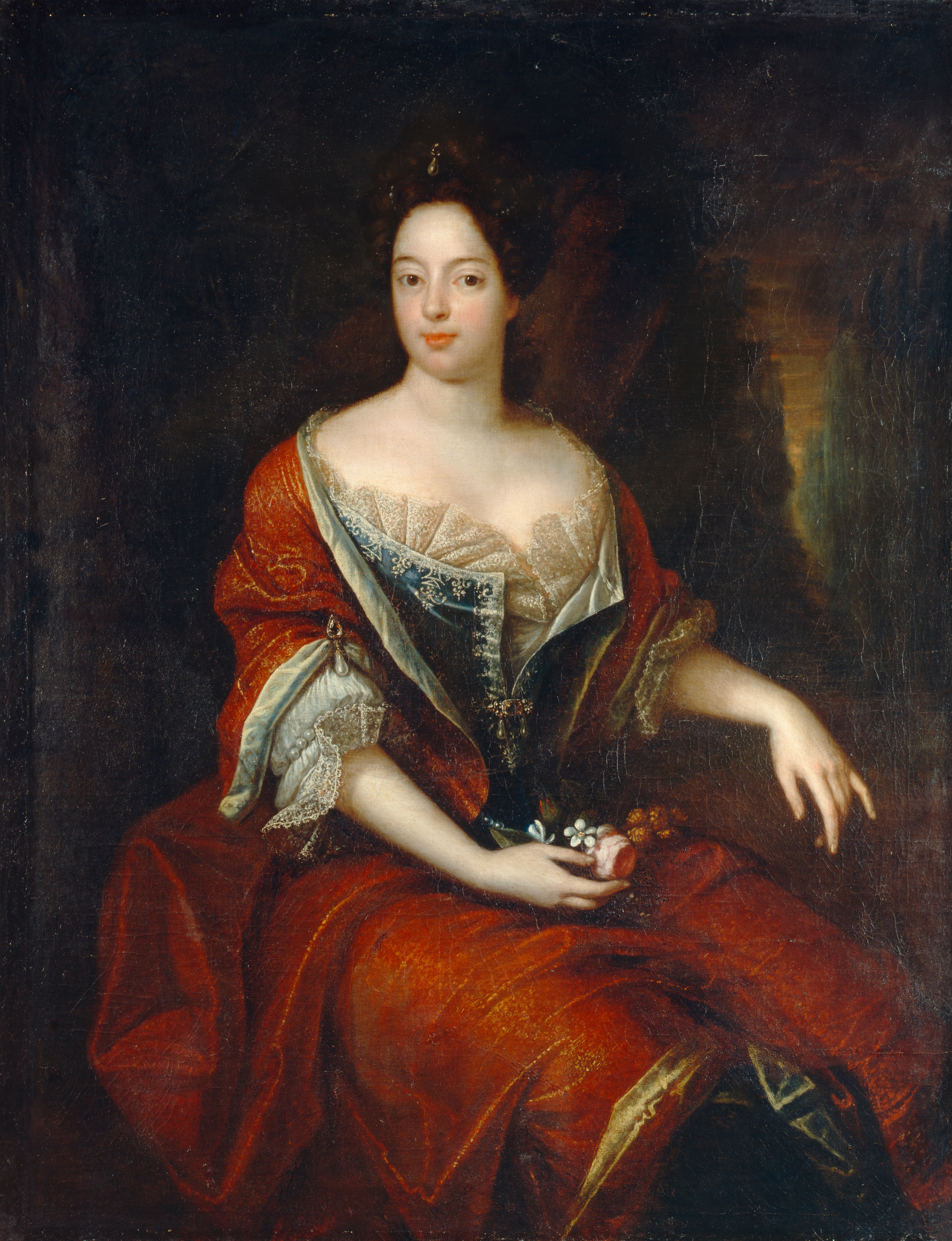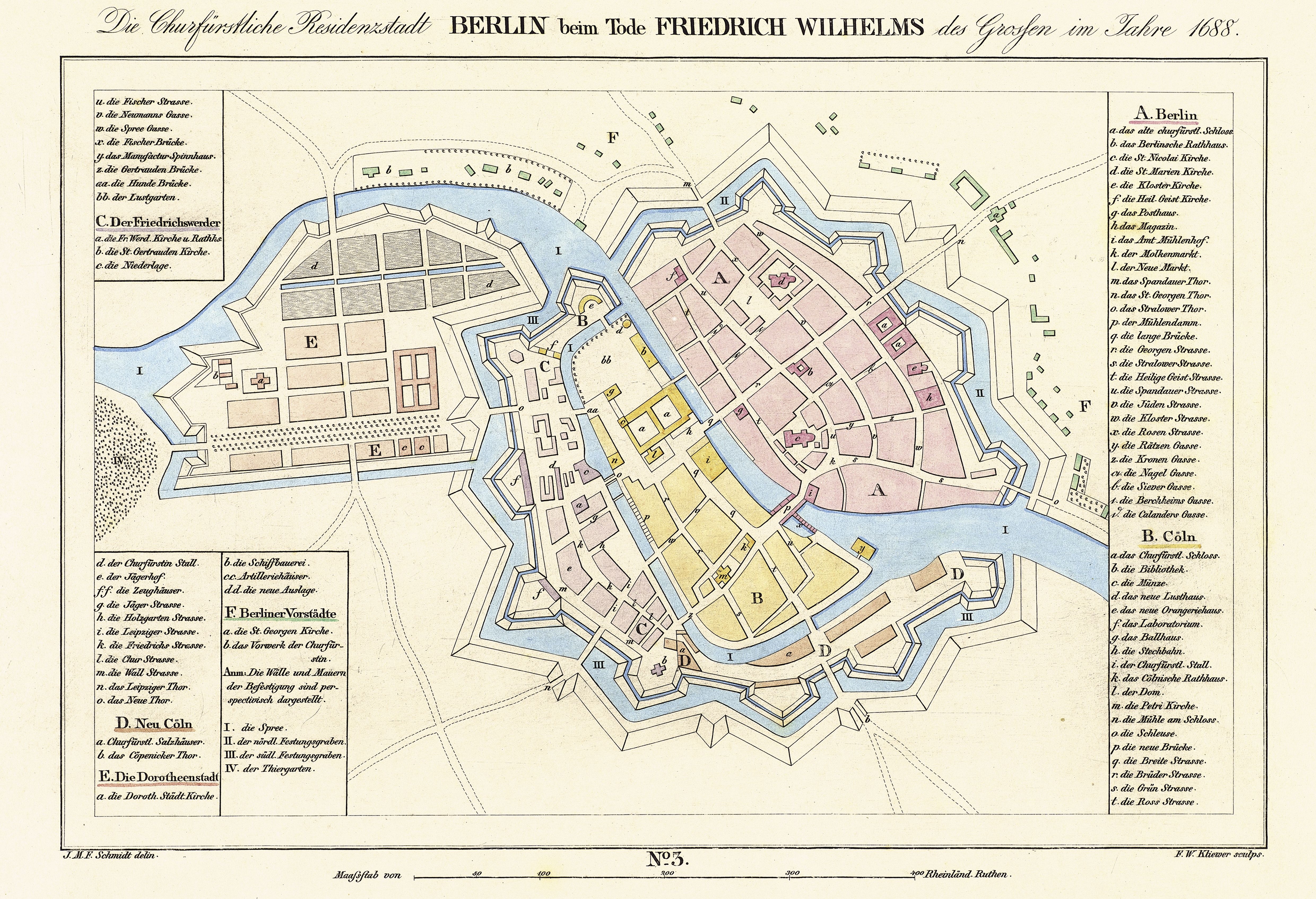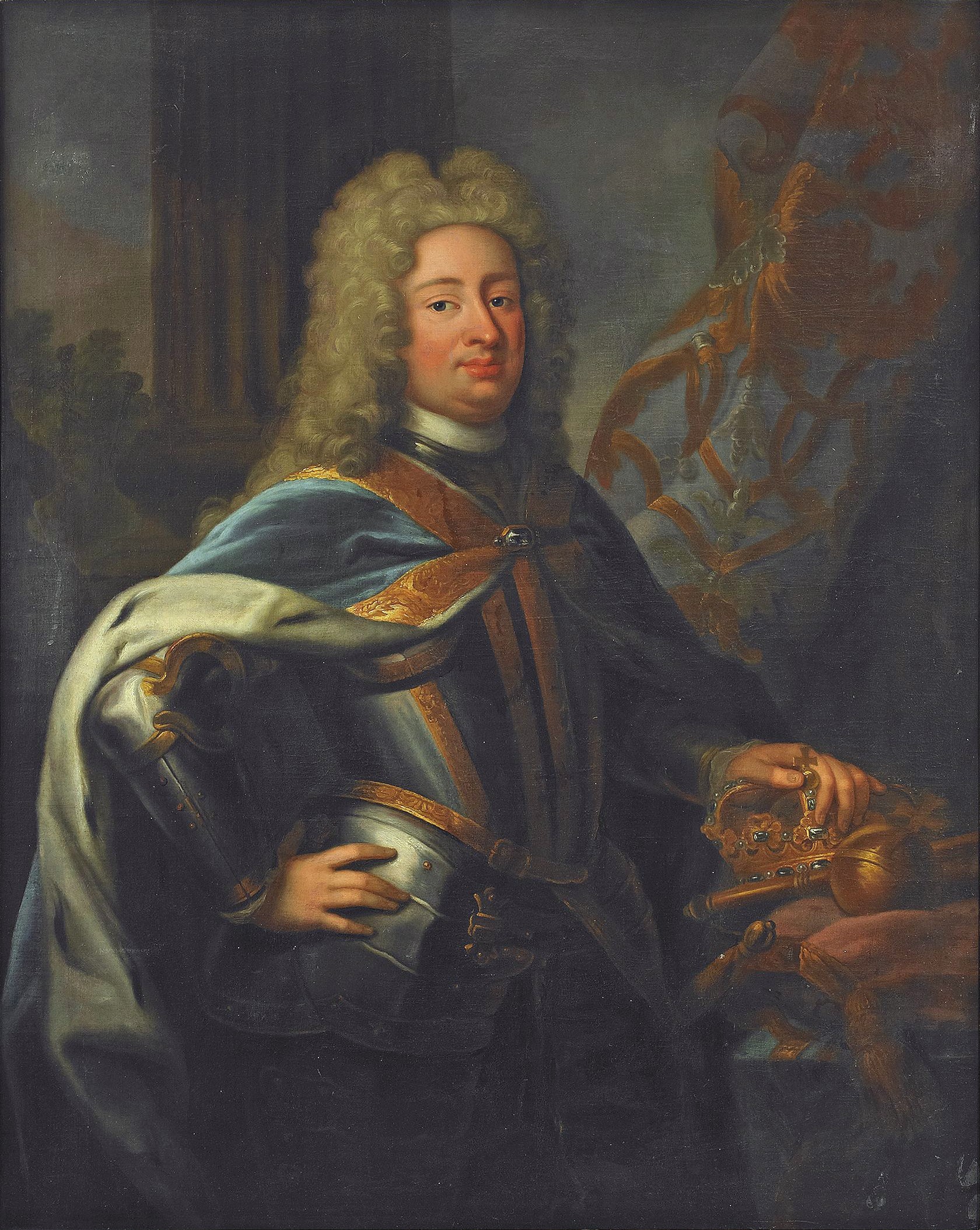|
Elisabeth Henriette Of Hesse-Kassel
Landgravine Elisabeth Henriëtte von Hessen-Kassel (18 November 1661 – 7 July 1683) was the daughter of William VI, Landgrave of Hesse-Kassel and Hedwig Sophia of Brandenburg (1623–1683) and electoral princess of Brandenburg through her marriage to Frederick I of Prussia. Biography Elisabeth Henriëtte was born in Kassel, Germany on 18 November 1661 to William VI, Landgrave of Hesse-Kassel. She was the youngest of seven; siblings included Queen Charlotte Amalie, William VII, Luise, Charles I, Philip, and George. She suffered from an unknown illness in 1677 that her mother treated with the milk cure, wherein a teenage Elisabeth suckled from a wet nurse for three weeks and eventually recovered. Years later, on 13 August 1679, she married her cousin, Frederick, Prince Elector of Brandenburg, in Potsdam after his plan to marry a sister of Holy Roman Emperor Leopold I fell through. They held court in Köpenick Palace in a district of Berlin. On 29 September 1680, Luis ... [...More Info...] [...Related Items...] OR: [Wikipedia] [Google] [Baidu] |
Frederick I Of Prussia
Frederick I (; 11 July 1657 – 25 February 1713), of the Hohenzollern dynasty, was (as Frederick III) List of margraves and electors of Brandenburg, Elector of Brandenburg (1688–1713) and Duke of Prussia in personal union (Brandenburg–Prussia). The latter function he upgraded to royalty, becoming the first King in Prussia (1701–1713). From 1707 he was in personal union the sovereign prince of the Principality of Neuchâtel. Biography Family Born in Königsberg, Frederick was the third son of Frederick William, Elector of Brandenburg by his father's first marriage to Louise Henriette of Orange-Nassau, eldest daughter of Frederick Henry, Prince of Orange and Amalia of Solms-Braunfels. His maternal cousin was King William III of England. Upon the death of his father on 29 April 1688, Frederick became Elector Frederick III of Electorate of Brandenburg, Brandenburg and Duchy of Prussia, Duke of Prussia. Right after ascending the throne Frederick founded a new city southerly ... [...More Info...] [...Related Items...] OR: [Wikipedia] [Google] [Baidu] |
Wet Nurse
A wet nurse is a woman who breastfeeding, breastfeeds and cares for another's child. Wet nurses are employed if the mother dies, if she is unable to nurse the child herself sufficiently or chooses not to do so. Wet-nursed children may be known as "milk-siblings", and in some societies, the families are linked by a special relationship of milk kinship. Wet-nursing existed in societies around the world until the invention of reliable formula milk in the 20th century. The practice has made a small comeback in the 21st century. Reasons A wet nurse can help when a mother is unable or unwilling to breastfeed her baby. Before the development of infant formula in the 20th century, wet-nursing could save a baby's life. There are many reasons why a mother is unable to produce sufficient breast milk, or in some cases to lactation, lactate at all. For example, she may have a chronic or acute illness, and either the illness itself, or the treatment for it, reduces or stops her milk. This abs ... [...More Info...] [...Related Items...] OR: [Wikipedia] [Google] [Baidu] |
Countess Amalie Elisabeth Of Hanau-Münzenberg
Amalie Elisabeth of Hanau-Münzenberg (28 January 1602– 18 August 1651) was Landgravine consort and Regent of Hesse-Kassel. She married the future William V, Landgrave of Hesse-Kassel in 1619 and became Landgravine upon his ascension to power in 1627. In 1637, military defeats forced her and William V into exile in East Frisia. Later that year, she became regent for their son William VI upon her husband's death. Through skillful diplomacy and military successes in the Thirty Years' War, she advanced the fortunes of Hesse-Kassel and influenced the Peace of Westphalia that brought the conflict to an end. She handed over an enlarged landgraviate to her son when she abdicated upon his majority in 1650. However, her health had deteriorated over the course of the war, and she died soon after her abdication in 1651. Early life Amalie Elisabeth was born between 2 and 3 o'clock in the afternoon of 28 January 1602 to Philip Louis II, Count of Hanau-Münzenberg and Countess Catharina Bel ... [...More Info...] [...Related Items...] OR: [Wikipedia] [Google] [Baidu] |
William V, Landgrave Of Hesse-Kassel
William V () (13 February 1602 – 21 September 1637), a member of the House of Hesse, was List of rulers of Hesse, Landgrave of Hesse-Kassel from 1627 to 1637. Having come to rule in unfavorable circumstances and in the midst of the Thirty Years' War, he continued to suffer losses of territory and wealth. Life William was born in Kassel, the son of Landgrave Maurice, Landgrave of Hesse-Kassel, Maurice of Hesse-Kassel and his consort Agnes of Solms-Laubach. His mother died shortly after his birth, and his father subsequently married Countess Juliane of Nassau-Siegen (1587–1643), Juliane of Nassau-Siegen. Maurice, of broad education and interests, inherited half of the estates held by the extinct landgraves of Hesse-Marburg in 1604. However, when he converted to Calvinism the next year, he entered into a protracted legal dispute with his Lutheranism, Lutheran cousin Landgrave Louis V, Landgrave of Hesse-Darmstadt, Louis V of Hesse-Darmstadt. The Aulic Council decided in favour ... [...More Info...] [...Related Items...] OR: [Wikipedia] [Google] [Baidu] |
Margravine Hedwig Sophie Of Brandenburg
Hedwig Sophia of Brandenburg (14 July 1623, Berlin – 26 June 1683, Schmalkalden) was Landgravine consort of Hesse-Kassel by marriage to William VI, Landgrave of Hesse-Kassel, and regent from 1663 until 1677 during the minority of her sons, William VII, Landgrave of Hesse-Kassel and Charles I, Landgrave of Hesse-Kassel. Life She was the daughter of George William, Elector of Brandenburg and Elizabeth Charlotte of the Palatinate. She married William VI, Landgrave of Hesse-Kassel in 1649. Regency Upon the death of her spouse in 1663, he was succeeded by their son, William VII, Landgrave of Hesse-Kassel. As his mother and guardian, she became regent. Her regency was terminated upon the death of her son in 1670, but as he was succeeded by her second son, Charles I, Landgrave of Hesse-Kassel Charles of Hesse-Kassel (; 3 August 1654 – 23 March 1730), member of the House of Hesse, was the Landgrave of Hesse-Kassel from 1670 to 1730. Childhood Charles was the second so ... [...More Info...] [...Related Items...] OR: [Wikipedia] [Google] [Baidu] |
Sophia Charlotte Of Hanover
Sophia Charlotte of Hanover (30 October 1668 – 1 February 1705) was the first Queen consort in Prussia as the wife of King Frederick I. She was the only daughter of Elector Ernest Augustus of Hanover and Sophia of the Palatinate. Her eldest brother, George Louis, succeeded to the British throne in 1714 as King George I. Early life Sophia Charlotte was born in Iburg Castle in the Prince-Bishopric of Osnabrück, where her father held the title of a Protestant prince-bishop. In 1672 her family moved to the new episcopal residence in Osnabrück and finally in 1679 to Hanover, when Ernest Augustus succeeded his brother Duke John Frederick of Brunswick-Lüneburg in the Principality of Calenberg. During her childhood, Sophia Charlotte visited the Kingdom of France with her mother in hopes of marrying Louis, Grand Dauphin, heir to the French throne. He later married Duchess Maria Anna Victoria of Bavaria instead, but Sophia Charlotte was also proposed as a possible bride fo ... [...More Info...] [...Related Items...] OR: [Wikipedia] [Google] [Baidu] |
Princess Dorothea Sophie Of Schleswig-Holstein-Sonderburg-Glücksburg
Princess Dorothea of Schleswig-Holstein-Sonderburg-Glücksburg (28 September 1636 – 6 August 1689), was Duchess consort of Brunswick-Lüneburg by marriage to Christian Louis, Duke of Brunswick-Lüneburg, and Electress of Brandenburg by marriage to Frederick William, Elector of Brandenburg, the "Great Elector". Biography Dorothea was born in Glücksburg and raised in Glücksburg Castle. She could claim royal blood through her descent from her great-grandfather King Christian III of Denmark, but her parents were of lower rank: Philip, Duke of Schleswig-Holstein-Sonderburg-Glücksburg, and Sophia Hedwig of Saxe-Lauenburg. She was the sister of Auguste of Schleswig-Holstein-Sonderburg-Glücksburg, the duchess of Augustenborg (named after her) by marriage. Duchess of Brunswick-Lüneburg In 1653, Dorothea married Christian Louis, Duke of Brunswick-Lüneburg, brother-in-law of King Frederick III of Denmark. They lived at Celle Castle. Her husband was considered hot-tempered and ... [...More Info...] [...Related Items...] OR: [Wikipedia] [Google] [Baidu] |
Smallpox
Smallpox was an infectious disease caused by Variola virus (often called Smallpox virus), which belongs to the genus '' Orthopoxvirus''. The last naturally occurring case was diagnosed in October 1977, and the World Health Organization (WHO) certified the global eradication of the disease in 1980, making smallpox the only human disease to have been eradicated to date. The initial symptoms of the disease included fever and vomiting. This was followed by formation of ulcers in the mouth and a skin rash. Over a number of days, the skin rash turned into the characteristic fluid-filled blisters with a dent in the center. The bumps then scabbed over and fell off, leaving scars. The disease was transmitted from one person to another primarily through prolonged face-to-face contact with an infected person or rarely via contaminated objects. Prevention was achieved mainly through the smallpox vaccine. Once the disease had developed, certain antiviral medications could poten ... [...More Info...] [...Related Items...] OR: [Wikipedia] [Google] [Baidu] |
Landgraviate Of Hesse-Kassel
The Landgraviate of Hesse-Kassel (), spelled Hesse-Cassel during its entire existence, also known as the Hessian Palatinate (), was a state of the Holy Roman Empire. The state was created in 1567 when the Landgraviate of Hesse was divided upon the death of Philip I, Landgrave of Hesse. His eldest son William IV inherited the northern half of the Landgraviate and the capital of Kassel. The other sons received the Landgraviates of Hesse-Marburg, Hesse-Rheinfels and Hesse-Darmstadt. During the Napoleonic reorganisation of the Empire in 1803, the Landgrave of Hesse-Kassel was elevated to an Electorate and Landgrave William IX became an Imperial Elector. Many members of the House of Hesse-Kassel served in the Danish military, gaining high ranks and power in the realm because many Landgraves were married to Danish princesses. Members of the family who are known to have served Denmark-Norway include Prince Frederik of Hesse-Kassel, Prince Frederick of Hesse-Kassel, and Prince ... [...More Info...] [...Related Items...] OR: [Wikipedia] [Google] [Baidu] |
Frederick I Of Sweden
Frederick I (; 28 April 1676 – 5 April 1751) was List of Swedish monarchs, King of Sweden from 1720 until his death, having been prince consort of Sweden from 1718 to 1720, and was also Landgrave of Landgraviate of Hesse-Kassel, Hesse-Kassel from 1730. He ascended the throne following the death of his brother-in-law absolute monarchy, absolutist Charles XII in the Great Northern War, and the abdication of his wife, Charles's sister and successor Ulrika Eleonora, Queen of Sweden, Ulrika Eleonora, after she had to relinquish most powers to the Riksdag of the Estates and thus chose to abdicate. His powerless reign and lack of legitimate heirs of his own saw his family's elimination from the line of succession after the parliamentary government dominated by pro-Revanchism, revanchist Hat Party politicians ventured into Hats' Russian War, a war with Russia, which ended in defeat and the Russian tsarina Elizabeth of Russia, Elizabeth getting Adolf Frederick of Sweden, Adolf Frederick o ... [...More Info...] [...Related Items...] OR: [Wikipedia] [Google] [Baidu] |
Berlin
Berlin ( ; ) is the Capital of Germany, capital and largest city of Germany, by both area and List of cities in Germany by population, population. With 3.7 million inhabitants, it has the List of cities in the European Union by population within city limits, highest population within its city limits of any city in the European Union. The city is also one of the states of Germany, being the List of German states by area, third smallest state in the country by area. Berlin is surrounded by the state of Brandenburg, and Brandenburg's capital Potsdam is nearby. The urban area of Berlin has a population of over 4.6 million and is therefore the most populous urban area in Germany. The Berlin/Brandenburg Metropolitan Region, Berlin-Brandenburg capital region has around 6.2 million inhabitants and is Germany's second-largest metropolitan region after the Rhine-Ruhr region, as well as the List of EU metropolitan areas by GDP, fifth-biggest metropolitan region by GDP in the European Union. ... [...More Info...] [...Related Items...] OR: [Wikipedia] [Google] [Baidu] |
Köpenick
Köpenick () is a historic town and locality (''Ortsteil'') in Berlin, situated at the confluence of the rivers Dahme and Spree in the south-east of the German capital. It was formerly known as Copanic and then Cöpenick, only officially adopting the current spelling in 1931. It is also known for the famous imposter '' Hauptmann von Köpenick''. Prior to its incorporation into Berlin in 1920, Köpenick had been an independent town. It then became a borough of Berlin, and with an area of , Berlin's largest. As a result of Berlin's 2001 administrative reform, the borough of Köpenick was merged with that of Treptow to create the current borough of Treptow-Köpenick. Köpenick is home to the Bundesliga football club 1. FC Union Berlin, who play at the Stadion An der Alten Försterei. Mellowpark, the largest outdoor skatepark in Europe, is located in the town. Geography Overview A large percentage of Köpenick's surface area is made up of pine forests and expanses of wate ... [...More Info...] [...Related Items...] OR: [Wikipedia] [Google] [Baidu] |







